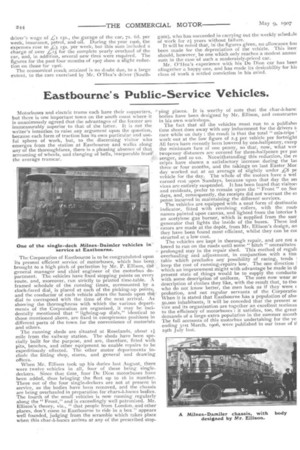The Traveller's Car.
Page 5

Page 6

If you've noticed an error in this article please click here to report it so we can fix it.
The increasing use of the motorcar as part of the stockl-trade of the travelling representatives of some of the irger manufacturers in this country prompted a member of le staff of "THE COMMERCIAL MOTOR I0 accept the inviition proffered by the London manager of Henry Leetham nd Sons, Limited, the well-known millers, of York, to ccornpany him on one of his country rounds. The gentletan in question, Mr. Rupert O'Hea, is the user of a De )ion car which was purchased by his company about the tiddle of 1904. He employs the car in his general capacity s supervisor of his employer's London trade, and, in addion to this work, Mr. O'Hea has a regular series of busiess calls which, by means of the car, he is able to deal 'all in three days of the week, and, thus, to have time left > attend to his duties on the Corn Exchange. Acting upon the conviction that, to prove a paying investtent, the car should never be allowed to stand idle, Mr. i'Hea, when he does not require the car himself, places at the disposal of one of the travellers on his staff, and in us way the car is kept running at least five days in each • eek. The work it is called upon to do from day to day , naturally, diversified, and ranges from the slow and .dious progress through the City, where only a small daily iileage is totalled, to lengthy runs in the country, when msiderably over too mites may be covered during the course f the day's round. On the occasion of the trip undertaken y the writer, the distance run by the car reached some 65 to ) miles, and, during this run, 20 business calls were made y Mr. O'Hea on his customers; the journey mapped out athe following day would easily reach an aggregate of round hundred miles. Altogether, Mr. O'Hea's carefully kept figures, which he was good enough to place at the service of the writer, show that the weekly average distance covered by the car reaches 225 miles. The trip under review was one typical of the work required of a car by the busy " commercial." Leaving its garage at Victoria at 9 a.m., the car first made for Croydon, where Mr. O'Hea resides, and there the actual round of calls began. From Croydon the way led through Purley, Kenley, Whyteleafe, and the Caterham Valley to Upper Caterham, and in each of these localities several calls were made, and finally Godstone was reached before lunch. After luncheon had been discussed, a move was made to Oxted and back to Godstone; from thence to Bletchingley, Merstham, Smithain, and back to Croydon, the car completing its day's work with the ten miles to its garage at Victoria.
Such a round as that described could not, it will be easily understood, be accomplished in the short space of a day by any other means than by motorcar. The capacity of the best horse is not up to the onerous standard of even a regular so miles a day, and train connections would admit of no such expeditious handling of the work entailed. The car, with a turn of speed on the road and a freedom from time-table restrictions, meets the case as no other means of locomotion could do, and any bar to its use on the ground of expense must arise only in the case of traders whose connection is but a small one, and one they do not desire to see magnified through effort on their part. On this question of expense, Mr. O'Hea's figures are very instructive. From February to December, 1905 (it months), the average weekly expenses (not including any allowance for deprecia
tion) work out a little under this sum including the
driver's. wage of ,6r is., the garage of the car, 7s. 6d. per week, insurance, petrol, and oil. During the year 1906, the expenses rose to..4;3 15s. per week, but this sum included a charge of over £15 for the complete yearly overhaul of the car, and, in addition, several new tires were required. The figures for the past four months of 1907 show a slight reduction on those for 19°6.
The economical result attained is no doubt due, to a large extent, to the care exercised by Mr. O'Hea's driver (South
gate), who has-succeeded in carrying but the weekly schedule of work for 2 years without failure. It will be noted that, in the figures given, no allowance has been made for the depreciation of the vehicle. This iterr should, however, be one which only reaches a modest annua sum in the case of such a moderately-priced car.
Mr. O'Hea's experience with his De Dion car has beer altogether a happy one, and has made its desirability for his class of work a settled conviction in his mind.


























